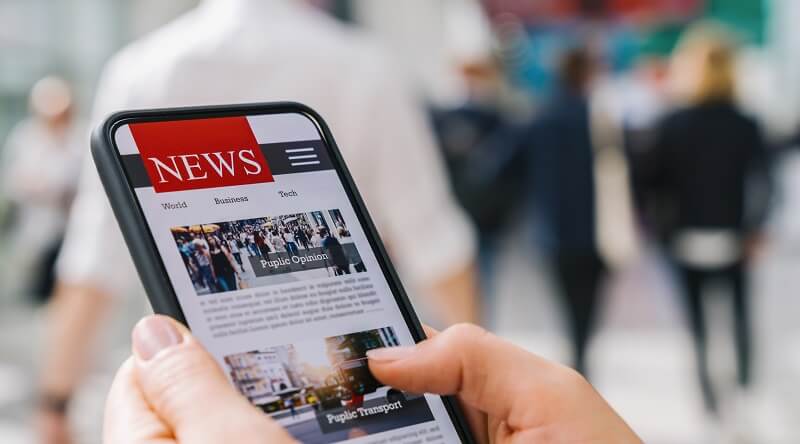The Basic Principles Of Popular News
The Basic Principles Of Popular News
Blog Article
What Does Popular News Mean?
Table of ContentsThings about Popular NewsSee This Report on Popular NewsThe Only Guide for Popular NewsNot known Details About Popular News
Age is also an aspect in the means people see the function of social media. Younger social networks news consumers are most likely to claim it has actually impacted their knowing right. Concerning half of social media sites information customers ages 18 to 29 (48%) state news on social media makes them better educated, compared with 37% of those 30 to 49, 28% of those 50 to 64, and 27% of those 65 and older.Journalists consider information values when establishing whether or not to cover an occasion or announcement. Perhaps the most essential component of newsworthiness is whether or not the information item being connected effects a news outlet's audience.
Research study on a state's new tax obligation code likely will not create the same rate of interest throughout state boundaries. Periodically experts can help localize a larger national story that affects even more than just a city or state.
If you are releasing newsworthy study, loophole in MarComm before the article being published to ensure that the pitch can highlight the most recent component of the tale: the magazine of the study. Occasions and announcements that include high-profile numbers are extra likely to generate media coverage. Check outs from nationwide numbers typically need months of preparation because of expected neighborhood interest.
Some Known Incorrect Statements About Popular News
Stories typically involve some kind of problem. Necessarily, these stories are often controversial to some extent. Thankfully, university staff and faculty are typically perceived as objective experts. We can help alleviate prospective reputational risk with these tales while likewise raising the chances of producing coverage. While several of the above news worths are intertwined, human rate of interest tales commonly stand apart.
Human interest aspects can include information value to various other tales that might seem doing not have in the various other values. The novelty or peculiarity of a scenario can help influence whether an information outlet is likely to cover a story. While this is not an extensive checklist, checking to see if your news product or occasion has these qualities before calling us will certainly aid you figure out which components hold the most news value.

7 Simple Techniques For Popular News
There is likewise substantial proof that more customers can begin to pay for news in the futureif authors can recognize them and offer them well. Half of those who do not pay for news proactively seek news and resemble clients in various means. And almost 2 in 10 of those that don't register for news now suggest they are inclined to start to pay in the future.
We then ask a collection of questions to establish whether people spend for certain sorts of information sources (Popular News). We asked people to call the resources they utilize most oftenwhether they spend for them or nothow they utilize them, the particular points they think about vital about them, and some associated inquiries about the expense and worth of that resource
People are attracted to news as a whole for 2 factors above others: A wish to be informed citizens (newspaper customers particularly are highly motivated by this) and since the magazine i was reading this they register for excels at covering certain topics regarding which those clients specifically care. While there are a host of reasons, the No.
Greater than 4 in 10 additionally cite the reality that loved ones register for the same item (Popular News). Greater than a 3rd of people state they initially subscribed in reaction to a price cut or promotion. In print, individuals additionally are moved greatly to subscribe to obtain coupons that save them cash, something that has untapped effects in electronic
The Greatest Guide To Popular News
Concerning fifty percent are "news seekers," implying they proactively seek information rather than mainly bumping right into it in an extra easy means, though the information that nonpayers are looking for (for currently, a minimum of) is frequently regarding national politics. Like clients, a number of these individuals additionally obtain information multiple times a day, make use of the information in ways similar to subscribers, and are interested in similar subjects, consisting of international or international information.

Of those who do pay, 54 percent subscribe to newspapers in print or electronically, which represents 29 percent of Americans in general. Many of them get a print magazine together with their paper and pay for two to four information resources in total amount, some much more. And while 53 percent are veteran clients (5+ years), greater than a quarter (27 percent) have actually purchased their newspaper subscription within the previous year.
Couple of print customers think it most likely they will certainly switch over to a digital-only subscription in the future, and over half of those that choose digital have actually never ever paid for a print version of the same see post source. Completely 75 percent of newspaper payers claim they mainly reviewed the paper in print, while 21 percent are mostly digital individuals, and 4 percent describe themselves as evenly split.
Report this page